Los caprichos
Los caprichos are a set of 80 prints in aquatint and etching created by the Spanish artist Francisco Goya in 1797 and 1798, and published as an album in 1799. The prints were an artistic experiment: a medium for Goya's condemnation of the universal follies and foolishness in the Spanish society in which he lived. The criticisms are far-ranging and acidic; he speaks against the predominance of superstition, the ignorance and inabilities of the various members of the ruling class, pedagogical short-comings, marital mistakes and the decline of rationality. Some of the prints have anticlerical themes. Goya described the series as depicting "the innumerable foibles and follies to be found in any civilized society, and from the common prejudices and deceitful practices which custom, ignorance or self-interest have made usual".[2]

Goya added brief explanations of each image to a manuscript, now in the Museo del Prado; these help greatly to explain his often cryptic intentions, as do the titles printed below each image. Despite the relatively vague language of Goya's captions in the Caprichos, as well as Goya’s public announcement that his themes were from the “extravagances and follies common to all society,” they were likely interpreted as references to well-known governmental and/or aristocratic figures. As he explained in the announcement, Goya chose subjects “from the multitude of follies and blunders common in every civil society, as well as from the vulgar prejudices and lies authorized by custom, ignorance or interest, those that he has thought most suitable matter for ridicule". Nonetheless, the Caprichos were withdrawn from sale after a brief period of time.
The work was a tour-de-force critique of 18th-century Spain, and humanity in general, from the point of view of the Enlightenment. The informal style, as well as the depiction of contemporary society found in Caprichos, makes them (and Goya himself) a precursor to the modernist movement almost a century later. The Sleep of Reason Produces Monsters in particular has attained an iconic status.
Goya's series, and the last group of prints in his series The Disasters of War, which he called "caprichos enfáticos" ("emphatic caprices"), are far from the spirit of light-hearted fantasy the term "caprice" usually suggests in art.
History
Los caprichos were withdrawn from public sale very shortly after their release in 1799, after only 27 copies of the set had been purchased.[3] In 1803, Goya offered the Caprichos' copper plates and the first edition's unsold sets to King Charles IV in return for a pension for his son.[4] Later in life, Goya wrote that he had felt it prudent to withdraw the prints from circulation due to the Inquisition.[5]
Subsequently, the set has been very influential, and not only in the visual arts. Its influence can be seen, for example, in:
- Granados' piano suite Goyescas, a work which has entered the standard piano repertory since its 2 parts were premiered in 1911 and 1914 respectively. It includes a number called El amor y la muerte (a title shared with no. 10 of the caprichos)
- Mario Castelnuovo-Tedesco's guitar work 24 caprichos de Goya, Op. 195 (1961)
Gallery
 Capricho No. 1: Francisco Goya y Lucientes, pintor (Francisco Goya y Lucientes, painter)
Capricho No. 1: Francisco Goya y Lucientes, pintor (Francisco Goya y Lucientes, painter) Capricho No. 2: El sí pronuncian y la mano alargan al primero que llega (They say yes and give their hand to the first comer)
Capricho No. 2: El sí pronuncian y la mano alargan al primero que llega (They say yes and give their hand to the first comer) Capricho No. 3: Que viene el coco (Here comes the bogeyman)
Capricho No. 3: Que viene el coco (Here comes the bogeyman)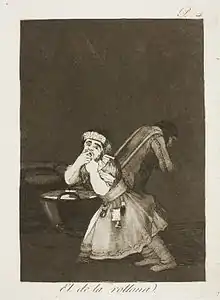 Capricho No. 4: El de la Rollona (Nanny's boy)
Capricho No. 4: El de la Rollona (Nanny's boy) Capricho No. 5: Tal para cual (Two of a kind)
Capricho No. 5: Tal para cual (Two of a kind) Capricho No. 6: Nadie se conoce (Nobody knows himself)
Capricho No. 6: Nadie se conoce (Nobody knows himself) Capricho No. 7: Ni así la distingue (Even thus he cannot make her out)
Capricho No. 7: Ni así la distingue (Even thus he cannot make her out)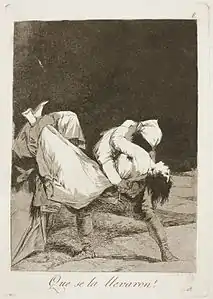 Capricho No. 8: ¡Que se la llevaron! (So they carried her off!)
Capricho No. 8: ¡Que se la llevaron! (So they carried her off!) Capricho No. 9: Tántalo (Tantalus)
Capricho No. 9: Tántalo (Tantalus) Capricho No. 10: El amor y la muerte (Love and death)
Capricho No. 10: El amor y la muerte (Love and death) Capricho No. 11: Muchachos al avío (Lads making ready)
Capricho No. 11: Muchachos al avío (Lads making ready) Capricho No. 12: A caza de dientes (Out hunting for teeth)
Capricho No. 12: A caza de dientes (Out hunting for teeth) Capricho No. 13: Están calientes (They are hot)
Capricho No. 13: Están calientes (They are hot) Capricho No. 14: ¡Qué sacrificio! (What a sacrifice!)
Capricho No. 14: ¡Qué sacrificio! (What a sacrifice!) Capricho No. 15: Bellos consejos (Good advice)
Capricho No. 15: Bellos consejos (Good advice) Capricho No. 16: Dios la perdone: y era su madre (For Heaven's sake: and it was her mother)
Capricho No. 16: Dios la perdone: y era su madre (For Heaven's sake: and it was her mother) Capricho No. 17: Bien tirada está (It is nicely stretched)
Capricho No. 17: Bien tirada está (It is nicely stretched) Capricho No. 18: Y se le quema la casa (And the house is on fire)
Capricho No. 18: Y se le quema la casa (And the house is on fire) Capricho No. 19: Todos caerán (Everyone will fall)
Capricho No. 19: Todos caerán (Everyone will fall) Capricho No. 20: Ya van desplumados (There they go plucked)
Capricho No. 20: Ya van desplumados (There they go plucked)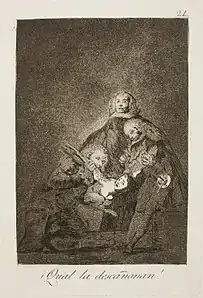 Capricho No. 21: ¡Cual la descañonan! (How they pluck her!)
Capricho No. 21: ¡Cual la descañonan! (How they pluck her!) Capricho No. 22: ¡Pobrecitas! (Poor little girls!)
Capricho No. 22: ¡Pobrecitas! (Poor little girls!) Capricho No. 23: Aquellos polvos (Those specks of dust)
Capricho No. 23: Aquellos polvos (Those specks of dust) Capricho No. 24: No hubo remedio (There was no help)
Capricho No. 24: No hubo remedio (There was no help) Capricho No. 25: Si quebró el cántaro (He broke the pitcher)
Capricho No. 25: Si quebró el cántaro (He broke the pitcher) Capricho No. 26: Ya tienen asiento (Now they are sitting well)
Capricho No. 26: Ya tienen asiento (Now they are sitting well) Capricho No. 27: ¿Quién más rendido? (Who more is surrendered?)
Capricho No. 27: ¿Quién más rendido? (Who more is surrendered?) Capricho No. 28: Chitón (Hush)
Capricho No. 28: Chitón (Hush) Capricho No. 29: Esto sí que es leer (Now that's reading)
Capricho No. 29: Esto sí que es leer (Now that's reading) Capricho No. 30: ¿Por qué esconderlos? (Why hide them?)
Capricho No. 30: ¿Por qué esconderlos? (Why hide them?) Capricho No. 31: Ruega por ella (She prays for her)
Capricho No. 31: Ruega por ella (She prays for her)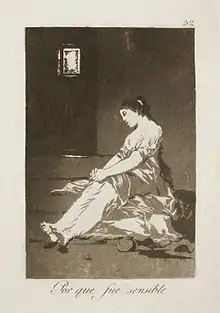 Capricho No. 32: Porque fue sensible (Because she was susceptible)
Capricho No. 32: Porque fue sensible (Because she was susceptible) Capricho No. 33: Al conde palatino (To the count palatine)
Capricho No. 33: Al conde palatino (To the count palatine) Capricho No. 34: Las rinde el sueño (Sleep overcomes them)
Capricho No. 34: Las rinde el sueño (Sleep overcomes them) Capricho No. 35: Le descañona (She fleeces him)
Capricho No. 35: Le descañona (She fleeces him) Capricho No. 36: Mala noche (A bad night)
Capricho No. 36: Mala noche (A bad night) Capricho No. 37: ¿Si sabra más el discípulo? (Might not the pupil know more?)
Capricho No. 37: ¿Si sabra más el discípulo? (Might not the pupil know more?)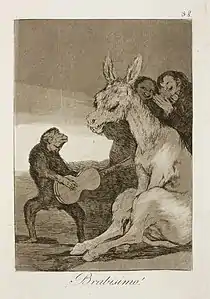 Capricho No. 38: ¡Bravísimo! (Bravissimo!)
Capricho No. 38: ¡Bravísimo! (Bravissimo!)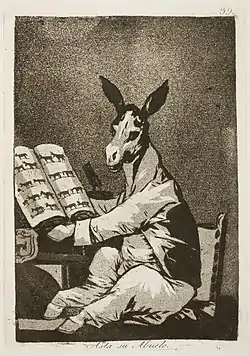 Capricho No. 39: Hasta su abuelo (And so was his grandfather)
Capricho No. 39: Hasta su abuelo (And so was his grandfather) Capricho No. 40: ¿De qué mal morirá? (Of what ill will he die?)
Capricho No. 40: ¿De qué mal morirá? (Of what ill will he die?) Capricho No. 41: Ni más ni menos (Neither more nor less)
Capricho No. 41: Ni más ni menos (Neither more nor less) Capricho No. 42: Tú que no puedes (Thou who cannot)
Capricho No. 42: Tú que no puedes (Thou who cannot) Capricho No. 43: El sueño de la razón produce monstruos (The Sleep of Reason Produces Monsters)
Capricho No. 43: El sueño de la razón produce monstruos (The Sleep of Reason Produces Monsters) Capricho No. 44: Hilan delgado (They spin finely)
Capricho No. 44: Hilan delgado (They spin finely) Capricho No. 45: Mucho hay que chupar (There is plenty to suck)
Capricho No. 45: Mucho hay que chupar (There is plenty to suck)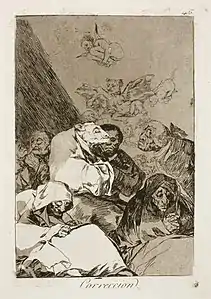 Capricho No. 46: Corrección (Correction)
Capricho No. 46: Corrección (Correction) Capricho No. 47: Obsequio al maestro (A gift for the master)
Capricho No. 47: Obsequio al maestro (A gift for the master)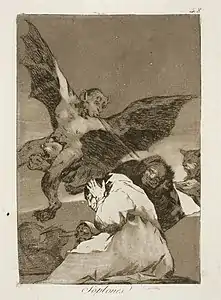 Capricho No. 48: Soplones (Snitches)
Capricho No. 48: Soplones (Snitches) Capricho No. 49: Duendecitos (Hobgoblins)
Capricho No. 49: Duendecitos (Hobgoblins) Capricho No. 50: Los Chinchillas (The Chinchillas)
Capricho No. 50: Los Chinchillas (The Chinchillas) Capricho No. 51: Se repulen (They spruce themselves up)
Capricho No. 51: Se repulen (They spruce themselves up) Capricho No. 52: ¡Lo que puede un sastre! (What a tailor can do!)
Capricho No. 52: ¡Lo que puede un sastre! (What a tailor can do!) Capricho No. 53: ¡Que pico de oro! (What a golden beak!)
Capricho No. 53: ¡Que pico de oro! (What a golden beak!) Capricho No. 54: El vergonzoso (The shameful one)
Capricho No. 54: El vergonzoso (The shameful one) Capricho No. 55: Hasta la muerte (Until death)
Capricho No. 55: Hasta la muerte (Until death) Capricho No. 56: Subir y bajar (To rise and to fall)
Capricho No. 56: Subir y bajar (To rise and to fall) Capricho No. 57: La filiación (The filiation)
Capricho No. 57: La filiación (The filiation) Capricho No. 58: Trágala, perro (Swallow it, dog)
Capricho No. 58: Trágala, perro (Swallow it, dog) Capricho No. 59: ¡Y aún no se van! (And still they don't go!)
Capricho No. 59: ¡Y aún no se van! (And still they don't go!) Capricho No. 60: Ensayos (Trials)
Capricho No. 60: Ensayos (Trials) Capricho No. 61: Volavérunt (They have flown)
Capricho No. 61: Volavérunt (They have flown) Capricho No. 62: ¡Quién lo creyera! (Who would have thought it!)
Capricho No. 62: ¡Quién lo creyera! (Who would have thought it!) Capricho No. 63: ¡Miren que graves! (Look how solemn they are!)
Capricho No. 63: ¡Miren que graves! (Look how solemn they are!) Capricho No. 64: Buen viaje (Bon voyage)
Capricho No. 64: Buen viaje (Bon voyage) Capricho No. 65: ¿Dónde va mamá? (Where is mommy going?)
Capricho No. 65: ¿Dónde va mamá? (Where is mommy going?) Capricho No. 66: Allá va eso (There it goes)
Capricho No. 66: Allá va eso (There it goes) Capricho No. 67: Aguarda que te unten (Wait till you've been anointed)
Capricho No. 67: Aguarda que te unten (Wait till you've been anointed) Capricho No. 68: Linda maestra (Pretty teacher)
Capricho No. 68: Linda maestra (Pretty teacher) Capricho No. 69: Sopla (Gust the wind)
Capricho No. 69: Sopla (Gust the wind) Capricho No. 70: Devota profesión (Devout profession)
Capricho No. 70: Devota profesión (Devout profession) Capricho No. 71: Si amanece, nos vamos (When day breaks we will be off)
Capricho No. 71: Si amanece, nos vamos (When day breaks we will be off) Capricho No. 72: No te escaparás (You will not escape)
Capricho No. 72: No te escaparás (You will not escape) Capricho No. 73: Mejor es holgar (It is better to be lazy)
Capricho No. 73: Mejor es holgar (It is better to be lazy) Capricho No. 74: No grites, tonta (Don't scream, stupid)
Capricho No. 74: No grites, tonta (Don't scream, stupid) Capricho No. 75: ¿No hay quién nos desate? (Can't anyone unleash us?)
Capricho No. 75: ¿No hay quién nos desate? (Can't anyone unleash us?) Capricho No. 76: Está vuestra merced... pues, como digo... ¡eh! ¡cuidado! si no... (You understand?... Well, as I say... eh! Look out! Otherwise...)
Capricho No. 76: Está vuestra merced... pues, como digo... ¡eh! ¡cuidado! si no... (You understand?... Well, as I say... eh! Look out! Otherwise...)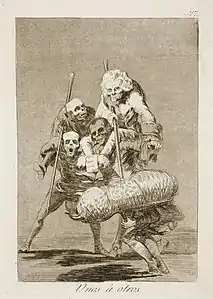 Capricho No. 77: Unos a otros (What one does to the other)
Capricho No. 77: Unos a otros (What one does to the other) Capricho No. 78: Despacha, que despiertan (Be quick, they are waking up)
Capricho No. 78: Despacha, que despiertan (Be quick, they are waking up) Capricho No. 79: Nadie nos ha visto (No one has seen us)
Capricho No. 79: Nadie nos ha visto (No one has seen us) Capricho No. 80: Ya es hora (It is time)
Capricho No. 80: Ya es hora (It is time)
Notes
- "The Sleep of Reason".
- Simon, Linda, "The Sleep of Reason", The World and I
- Goya, 3
- "Goya (y Lucientes), Francisco (José) de". Grove Art Online. doi:10.1093/gao/9781884446054.001.0001/oao-9781884446054-e-7000033882. Retrieved 2020-11-23. (subscription required)
- Boime, 264
References
- Albert Boime, A Social History of Modern Art. University of Chicago Press, 1991. ISBN 0-226-06335-6.
- John J. Ciofalo, The Self-Portraits of Francisco Goya. Cambridge University Press, 2001.
- Francisco Goya, Los Caprichos. New York: Dover Publications, 1969.
Further reading
- Goya in the Metropolitan Museum of Art. New York: The Metropolitan Museum of Art. 1995. ISBN 9780870997525.
- Stayton, Kevin L. (2014). Brooklyn Museum Highlights. Brooklyn, NY: Brooklyn Museum. p. 141. ISBN 9780872731752.
External links
| Wikimedia Commons has media related to Caprichos. |
